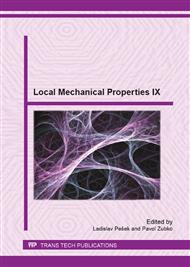p.83
p.87
p.91
p.96
p.100
p.104
p.108
p.112
p.116
Microstructure and Local Mechanical Properties of Cu-Co Alloys after Severe Plastic Deformation
Abstract:
Microstructure of Cu-2wt.%Co alloy after various heat treatment (and hence with various phase constitution) was studied after equal-channel angular pressing (ECAP) using transmission electron microscopy (TEM) and electron backscatter diffraction (EBSD) technique in a scanning electron microscope (SEM). We also focused on local mechanical properties measured across the section perpendicular to the ECAP extrusion direction. Starting from the grain size well above 1mm in the Cu-2wt.%Co solid solution, ECAP subsequently reduces grain size down to the submicron level. A comparison with pure Cu shows that the grain size homogenization is shifted towards higher number of ECAP passes. Fine dispersion of precipitates further slows down the grain refinement and grain size homogenization during ECAP processing. Local mechanical properties measured across the section perpendicular to the ECAP extrusion direction reveal systematic inhomogeneities of deformed microstructure caused by local gradients of temperature and pressure and by the processing geometry itself. This should be considered while characterizing the microstructure by a single EBSD measurement on a small selected area.
Info:
Periodical:
Pages:
100-103
Citation:
Online since:
September 2013
Authors:
Price:
Сopyright:
© 2014 Trans Tech Publications Ltd. All Rights Reserved
Share:
Citation:


